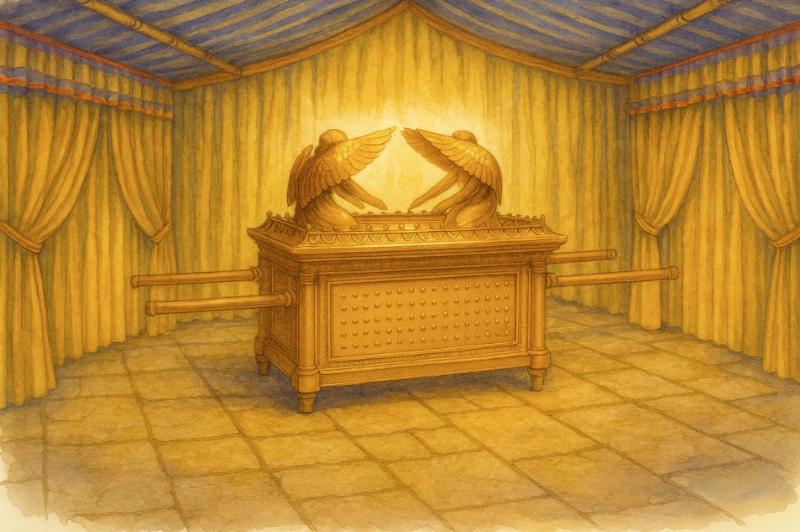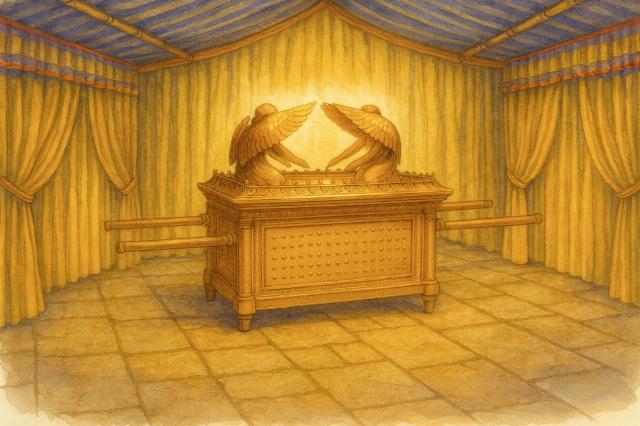


One of the things that the Arabs living in the Gaza Strip and along Israel’s eastern border with Jordan (aka “the West Bank”) routinely do is destroy anything ancient that the Earth periodically churns up. They do so because they know there’s a substantial likelihood that these archaeological finds are proof of the Bible’s historical authenticity and the Jews’ non-stop ties to the land over four millennia.
However, despite its location in the West Bank, the modern marauders haven’t destroyed the digs at what was once the ancient community of Shiloh, a thriving and important location at the time of the Judges (roughly the 15th to 11th centuries B.C.). And that’s a great thing because the Associates for Biblical Research believe that they might have found the location at Shiloh where the Tabernacle and the Ark of the Covenant once stood.

Image by ChatGPT.
For three centuries, Shiloh was Israel’s first holy center and capital, featuring prominently in both Joshua and Judges. It was the home of a stone tabernacle, inside of which was the Ark of the Covenant. The Ark, in turn, held the two tablets on which God had inscribed the Ten Commandments, Aaron’s rod, and a golden pot of manna.
After a particularly dispiriting loss during the Israelites’ war with the Philistines (around 1000 B.C.), the Israelites, looking ahead to the next battle, hoped that the Ark would be a spiritual shield against their implacable enemy, so they brought the Ark to the battlefield. The Lord, however, was not with them. There was a terrible slaughter, which ended with the Philistines capturing the Ark. As described in 1 Samuel 4:
Thus the word of Samuel came to all Israel.
Now the Israelites went out to meet the Philistines in battle and camped at Ebenezer, while the Philistines camped at Aphek. The Philistines arrayed themselves against Israel, and as the battle spread, Israel was defeated by the Philistines, who struck down about four thousand men on the battlefield.
When the troops returned to the camp, the elders of Israel asked, “Why has the LORD brought defeat on us before the Philistines today? Let us bring the ark of the covenant of the LORD from Shiloh, so that it may go with us to save us from the hand of our enemies.”
So the people sent men to Shiloh, and they brought back the ark of the covenant of the LORD of Hosts, who sits enthroned between the cherubim. And the two sons of Eli, Hophni and Phinehas, were there with the ark of the covenant of God.
When the ark of the covenant of the LORD entered the camp, all the Israelites raised such a great shout that it shook the ground.
On hearing the noise of the shout, the Philistines asked, “What is this loud shouting in the camp of the Hebrews?”
And when they realized that the ark of the LORD had entered the camp, 7the Philistines were afraid. “The gods have enteredb their camp!” they said. “Woe to us, for nothing like this has happened before. 8Woe to us! Who will deliver us from the hand of these mighty gods? These are the gods who struck the Egyptians with all kinds of plagues in the wilderness. 9Take courage and be men, O Philistines! Otherwise, you will serve the Hebrews just as they served you. Now be men and fight!”
So the Philistines fought, and Israel was defeated, and each man fled to his tent. The slaughter was very great—thirty thousand foot soldiers of Israel fell. The ark of God was captured, and Eli’s two sons, Hophni and Phinehas, died.
The Ark was eventually restored to Israel, although it vanished forever around the time of the Babylonian captivity, some four hundred years after events at Shiloh.
While the Ark remains missing, archaeologists think they’ve found the spot at which the Tabernacle holding the Ark stood before the Israelites carted the Ark off to the battlefield. That’s because they found a major sacrificial spot immediately adjacent to a stone structure that shares the same measurements as those described in the Bible:
Dr Scott Stripling, director of the Tel Shiloh dig, said: ‘We’ve uncovered a monumental building from the Iron I period that matches the biblical dimensions of the Tabernacle. The structure is oriented east-west and divided in a 2:1 ratio, just as described in scripture.’
Adding to the discovery, excavators have found over 100,000 animal bones, mostly from sheep, goats, and cattle, and predominantly from the right side of the animals, aligning with Leviticus 7, which states that the right side was reserved for priestly offerings.
‘This isn’t a coincidence,’ Dr Stripling told The Christian Broadcasting Network. ‘The evidence of sacrificial rituals here is overwhelming, and it matches the biblical account to a degree that’s hard to ignore.’
Pottery found among the bones dates back to the same period, reinforcing the site’s connection to the Tabernacle era, which the Bible says lasted nearly 400 years before the Temple was built in Jerusalem.
In addition, working backward from the Tabernacle’s location, the archaeologists believe they may also have found the location at which the last judge, Eli, was sitting when he learned that both his sons had died during the battle and that the Ark had been seized. Upon hearing about the Ark, the 98-year-old Eli toppled from his chair by the city gate, “and being old and heavy...broke his neck and died.”
Jewish blood has been intermingled with the soil of Israel for 4,000 years—and the soil keeps rearing up and proving that over and over again. The pronouncements of quislings and Vichys in Europe, terrified by the Muslims they’ve imported into their countries (usually against the will of the people over whom they govern), will not change that. Am Israel Chai!
